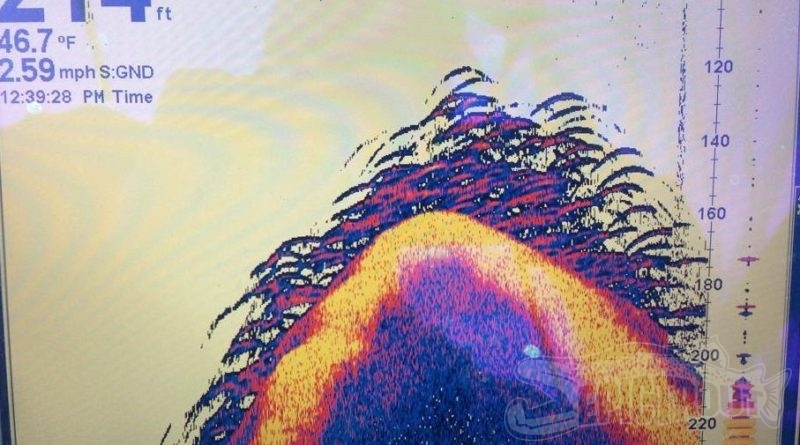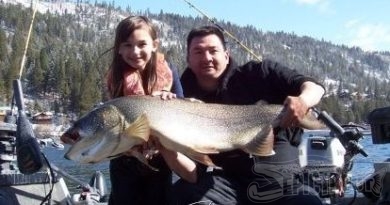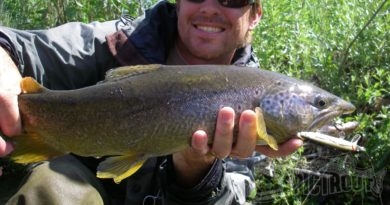What are you looking at ?
Have you ever been out fishing and look over at your sonar and thought “What the heck is that?” Don’t feel bad, it has happened to all of us. Sometimes understanding what’s on your sonar screen can be a little confusing. Fishermen and musicians, for example, can be somewhat alike. For instance, take a drummer in a rock ‘n roll band. A good majority of them just wing it. They play drums by using their ears, heart and soul. As talented as they are as musicians, some drummers don’t have a clue when it comes to reading a sheet of music. Or, think of a musician that plays in the orchestra. That musician is trained to read a sheet of music and some have the ability to hear each note that is listed on the page by just looking at it. Most fisherman do a great job with catching fish and fishing itself but some struggle to understand what’s on the sonar screen. They use the sonar for two main features. One, finding the depth below the boat and two, seeing suspended fish. In part one of the series “What are you looking at?” I would like to talk about Side Imaging and give you some of the other useful features that will help you catch more fish.
When I work shows and seminars for Humminbird I nowadays I’m constantly asked about Side Imaging. What is it? How dose it work? How can it put more fish in the boat? Side Imaging is simply the ability to look 240 feet to each side of the boat giving you a total of 480 feet of total coverage. It works by sending a fan-shaped razor thin beam out of each side of the transducer. The beams reveal structure and contour changes with crystal clarity.
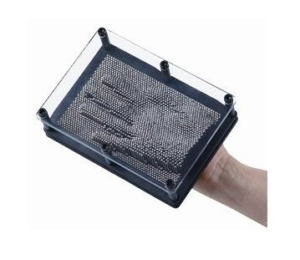

How do I interpret what’s on the screen? I will describe what I see in two ways. First, I think of a toy named “Pin Art” that most of us have played in our youth. When you press your hand against the pin it make a detailed image of your hand on the other side. Second is a time lapse photo. The image on the top of the screen is what you see in present time and the image at the bottom of the screen is the past.

How can Side Imaging make you a better fishermen? Side Imaging simply saves you time when searching for structure and baitfish. It’s not meant to replace traditional sonar. It’s just another tool to let you know where the fish are. I will use this as an example. Over the past few drought seasons in Northern California, the reservoir has dropped to an all time low. With the low water level its like fishing a new lake every time I go. With my Humminbird Side Imaging I can see up to 240 feet off of the side of the boat instead of the traditional 10 feet directly below the boat. I would make 3 or 4 passes in a cove and I would see every rock pile, creek channel and shelves. I could find out more about the cove in just a few minutes rather than days without Side Imaging. As I’m getting my data from the Side Imaging let’s say there is a rock pile in the middle of the cove 75 feet to the left of my boat. I simply mark the rocks on the GPS location by dragging the cursor to the structure on the screen and add a waypoint. This feature gives me the ability to easily map out all the key structures. With the Humminbird Sonar you can take a screenshot in just seconds and easily attach it to the way point. Taking a screenshot allows me to have a photo to remember what is located at each waypoint for future trips.
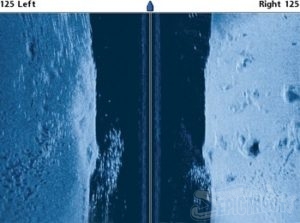
When looking for bait balls in open water the Humminbird Side Imaging is invaluable. Once you locate a school of bait fish you have also discovered where the hungry trophy size trout will be. I like to set my Side Imaging 100 feet out off of each side of the boat. I’m now looking at a 200 foot path as I troll down the lake with an extra long set back to my lure roughly 300 feet. Let’s say I see a school of bait fish 80 feet to the starboard side of the boat. I then make the adjustment needed to steer my lure directly through the bait fish. My boat never alerts the predator fish that I was there. What I really like is how much time it saves me after I have caught a fish from a bait ball. A lot of time can pass while getting a trophy size fish to the boat. By the time you are ready to start fishing again your boat could have drifted 100 feet or more from where you hooked your fish and who knows where the bait ball swam off to. With traditional sonar you make your best educated guess and head out hoping you made the right choice. Guess right and find the bait and your back to catching fish but guess wrong and you can be fish less as you pray you find the bait ball again. With the Humminbird Side Imaging I make a couple of circles with the boat. I start with a small circle and then graduate to larger circles until I will have found the school again and then line up my trolling run.

The question asked of me over and over again at seminars and shows is “Does my Side Imaging really work?” Recently while working a show I was approached by two older men who instantly reminded me of Jack Lemmon and Walter Matthau from the movie Grumpy Old Men. I will refer the taller man of the two as “Walter.” Walter pointed to a photo of a shipwrecked sailboat taken by a sonar in a Humminbird brochure. “Ever see anything like that on the fish finder in your boat.” Walter croaked. “No,” I replied. I started to explain that I fish the Sierra Nevada and that I have never seen a sunken sailboat, but I do see plenty of structure. When Walter blurted out “You guys can put anything you want on these brochures. I ain’t never seen anything that looks as good as this photo on my screen.” As I stood there in front of them thinking of something clever to say, Walter starts in again. “Seeing is believing and you are going stand here and tell me you ain’t ever seen a sunken boat, school bus, or bridge like the ones in your brochure on your sonar screen?” Walter hands me the brochure with a look of disgust on his face. “Next he is going to tell us about Bigfoot,” he mumbled and then both men chuckled and turned and walked away. Just before they reached the next vendor table Walter blurts out, “Don’t come back next year unless you have some proof.”
So here was my challenge to find a man-made piece of structure in the lakes I fish near my home in Reno, Nevada. I was once told that before the Boca and Stampede Dams were built, there were thriving businesses located below the current water lines. If this were true I might be able to find some remnant with my new Humminbird electronics. Before mechanization brought cheap and readily available ice to California in the early 20th century, ice was harvested along lakes and rivers in colder climates. Truckee’s cold mountain air and nearby waters provided an ideal setting for ice companies to thrive. In 1868 the Boca Ice Company began operations. At its peak, Truckee’s ice harvest produced 300,000 tons of ice in a single year. But World War I soon brought mechanization to the ice industry and shut down the old ice houses, leaving abandoned buildings and crumbling foundations. So I thought to myself the foundations should still be visible to sonar just like a rock pile would be visible. After a few more weeks of online research and a couple of emails to a local historian, I actually came up with some old photos and a map detailing location of the structures.
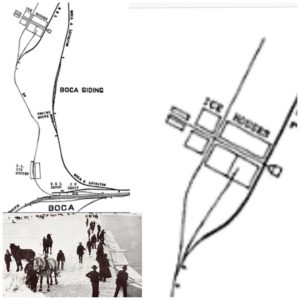
I was set for my big adventure in searching for a foundation to a building that was built almost 150 years ago and has been covered by water for the last 75 years after the Boca Dam was built. I first thought it might take a weekend to find the structure with my new electronics. I had a good idea where it was and I was confident I could find it, but could I take a screen shot photo that was clear enough to prove there was no doubt that the foundation existed? It took me only 20 minutes to find the foundation and I was able to take an incredible screen shot of the foundation. The next question I asked myself was now that I proved that these new sonar units really work, will that proof make the grumpy old men happy? Probably not, but because of those two elderly men I now have a photo of the Boca Ice Company that was built more than 100 years before I was even born to share with the historian and that makes me pretty darn happy.
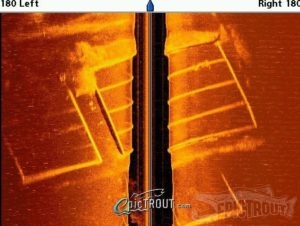
So give one of the new sonar units a try. I think you will like them. Take the time to learn how to interpret what on the screen and you will love them.
Brad Stout

